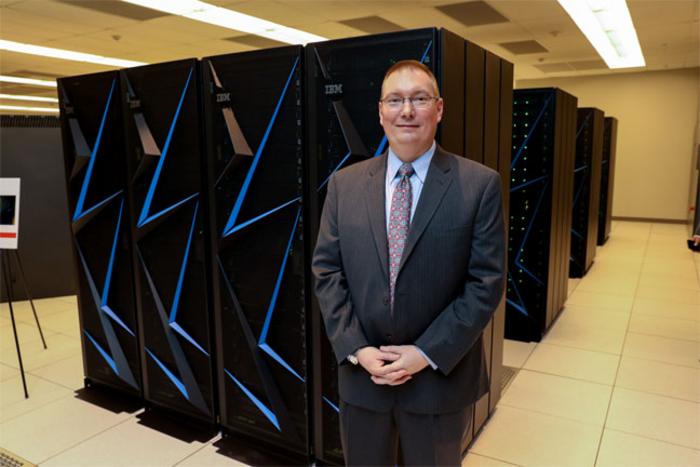When a star goes supernova, a massive burst of neutrinos is the first signal that can escape the density of the collapsing star. Detecting and analyzing this phenomenon in real time would allow us insight into stellar dynamics and, potentially, black hole formation. Detection of these types of signals from modern physics detectors is notoriously hard and presents computational challenges that push the bounds of modern and next-generation computing. Transmitting and analyzing the data from the massive particle physics detectors to the next generation of extreme-scale computing will require detailed modeling of the networking, hardware, and leadership class computing systems. These models will allow researchers to find and optimize the computing pathways, configurations, and infrastructure topologies so that they can handle these massive data loads.

Credit: Rensselaer Polytechnic Institute
When a star goes supernova, a massive burst of neutrinos is the first signal that can escape the density of the collapsing star. Detecting and analyzing this phenomenon in real time would allow us insight into stellar dynamics and, potentially, black hole formation. Detection of these types of signals from modern physics detectors is notoriously hard and presents computational challenges that push the bounds of modern and next-generation computing. Transmitting and analyzing the data from the massive particle physics detectors to the next generation of extreme-scale computing will require detailed modeling of the networking, hardware, and leadership class computing systems. These models will allow researchers to find and optimize the computing pathways, configurations, and infrastructure topologies so that they can handle these massive data loads.
To meet these challenges, the Tachyon Project – named for a hypothetical atomic particle that travels faster than light – has been awarded $7.5 million from the U.S. Department of Energy (DOE) High Energy Physics (HEP) program to model, simulate, and validate the transport, transmission, and analysis of particle physics data using extreme-scale computing systems, artificial intelligence (AI), and machine learning (ML) techniques. Christopher Carothers, Ph.D., professor and director of Rensselaer Polytechnic Institute’s Center for Computational Innovations, which has been awarded $1.5 million of the total grant, will serve as principal investigator for the project.
Over the five years of the DOE grant, the Tachyon Project will utilize data and information from the Fermi National Accelerator Laboratory and Argonne National lab computing facilities. The project will model the entire distributed infrastructure required to transmit and analyze data from the international Deep Underground Neutrino Experiment (DUNE), hosted by Fermilab, to the computing facilities at the Argonne Leadership Computing Facility (ALCF) in near real time. It will do this by creating surrogate machine learning models trained on both historical facility data and massively parallel simulation data. This will enable scientists at Fermilab to predict and tune workflow performance, improve resiliency, and increase the rate of scientific discovery in both the experimental and computing fields.
Joining Carothers in this research are co-PIs Kevin Brown, Argonne National Laboratory; Andrew Norman, Fermi National Accelerator Laboratory; Zhiling Lan, University of Illinois Chicago; Kwan-Liu Ma, UC Davis; Tanwi Mallick, Argonne National Laboratory; Robert Ross, Argonne National Laboratory; and Kai Shu, Illinois Institute of Technology.
About Rensselaer Polytechnic Institute:
Founded in 1824, Rensselaer Polytechnic Institute is America’s first technological research university. Rensselaer encompasses five schools, over 30 research centers, more than 140 academic programs including 25 new programs, and a dynamic community made up of over 6,800 students and 110,000 living alumni. Rensselaer faculty and alumni include upwards of 155 National Academy members, six members of the National Inventors Hall of Fame, six National Medal of Technology winners, six National Medal of Science winners, and a Nobel Prize winner in Physics. With nearly 200 years of experience advancing scientific and technological knowledge, Rensselaer remains focused on addressing global challenges with a spirit of ingenuity and collaboration. To learn more, please visit www.rpi.edu.
Contact:
Katie Malatino
Senior Communications Specialist
[email protected]
838-240-5691
For general inquiries: [email protected]
Visit the Rensselaer research and discovery blog: https://everydaymatters.rpi.edu/
Follow us on Twitter: @RPINews
###




